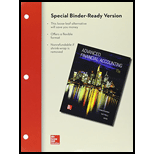
Concept explainers
a.
Introduction:
Consolidating entries to complete a consolidated worksheet for 20X8
a.
Explanation of Solution
Journal entries
| S.no | Date | Particulars | Debit | Credit |
| 1 | Income from subsidiary | $32,000 | ||
| Income from SF stock | $32,000 | |||
| (To record C’s 80% share of S’s income) | ||||
| 2 | Income to non- controlling interest | $9,000 | ||
| Non-controlling interest | $9,000 | |||
| (To record non-controlling interest of net income of S) | ||||
| 3 | Common stock- SF | $90,000 | ||
| $220,000 | ||||
| Investment in SF stock | $248,000 | |||
| Non- controlling stock | $62,000 | |||
| (To record basic elimination entry) | ||||
| 4 | Retained earnings as on Jan 1 | $16,000 | ||
| Non-controlling interest | $4,000 | |||
| Cost of goods sold | $20,000 | |||
| (To record reversal of the deferred gross profit) | ||||
| 5 | Sales | $150,000 | ||
| Cost of goods sold | $135,000 | |||
| Inventory | $15,000 | |||
| To eliminate the unrealized inventory profit) |
- Recording the eliminating entry for elimination of income from subsidiary.
- Recording the eliminating entry for assigning income to non-controlling interest.
- Recording the eliminating entry for elimination of beginning investment balance.
- Recording the eliminating entry for elimination of beginning inventory profit.
- Recording the eliminating entry for elimination of unrealized inventory profit.
b.
Introduction: The consolidated income is the difference between the sum of the total operating income of the parent company and the net income of the subsidiary and the unrealized inventory profits of the two. The income assigned to controlling interest is the difference between income assigned to non-controlling interest and the consolidated net income.
The amount reported as consolidated net income and income assigned to the controlling interest.
b.
Answer to Problem 6.22P
The consolidated net income is $90,000
The income assigned to controlling interest is $81,000
Explanation of Solution
Consolidated net income
| Particulars | Amount | Amount |
| Operating income of CA | $45,000 | |
| Net income of SF | $40,000 | |
| Total income | $85,000 | |
| inventory profits realized in 20X7 | $20,000 | |
| Unrealized inventory profits for 20X8 | ($15,000) | |
| Consolidated net income | $90,000 |
Income assigned to controlling interest
| Particulars | Amount |
| Consolidated net income | $90,000 |
| Less: income assigned to non- controlling interest | ($9,000) |
| Income assigned to controlling interest | $81,000 |
c.
Introduction: A non-controlling interest refers to an ownership position in which the shareholders hold less than 50 percent of the total shares in the company and have no control over its decisions.
Income assigned to non- controlling shareholders.
c.
Answer to Problem 6.22P
Income assigned to non-controlling shareholders is $67,000.
Explanation of Solution
| Particulars | Amount |
| Common stock | $90,000 |
| Retained earnings | $260,000 |
| Less: unrealized inventory profit | ($15,000) |
| Proportion of stock held by non-controlling interest | 20% |
| Income assigned to non- controlling shareholders | $67,000 |
Want to see more full solutions like this?
Chapter 6 Solutions
LOOSE-LEAF Advanced Financial Accounting with Connect

 AccountingAccountingISBN:9781337272094Author:WARREN, Carl S., Reeve, James M., Duchac, Jonathan E.Publisher:Cengage Learning,
AccountingAccountingISBN:9781337272094Author:WARREN, Carl S., Reeve, James M., Duchac, Jonathan E.Publisher:Cengage Learning, Accounting Information SystemsAccountingISBN:9781337619202Author:Hall, James A.Publisher:Cengage Learning,
Accounting Information SystemsAccountingISBN:9781337619202Author:Hall, James A.Publisher:Cengage Learning, Horngren's Cost Accounting: A Managerial Emphasis...AccountingISBN:9780134475585Author:Srikant M. Datar, Madhav V. RajanPublisher:PEARSON
Horngren's Cost Accounting: A Managerial Emphasis...AccountingISBN:9780134475585Author:Srikant M. Datar, Madhav V. RajanPublisher:PEARSON Intermediate AccountingAccountingISBN:9781259722660Author:J. David Spiceland, Mark W. Nelson, Wayne M ThomasPublisher:McGraw-Hill Education
Intermediate AccountingAccountingISBN:9781259722660Author:J. David Spiceland, Mark W. Nelson, Wayne M ThomasPublisher:McGraw-Hill Education Financial and Managerial AccountingAccountingISBN:9781259726705Author:John J Wild, Ken W. Shaw, Barbara Chiappetta Fundamental Accounting PrinciplesPublisher:McGraw-Hill Education
Financial and Managerial AccountingAccountingISBN:9781259726705Author:John J Wild, Ken W. Shaw, Barbara Chiappetta Fundamental Accounting PrinciplesPublisher:McGraw-Hill Education





